CHEVROLET TRACKER 1997 Manual Online
Manufacturer: CHEVROLET, Model Year: 1997, Model line: TRACKER, Model: CHEVROLET TRACKER 1997Pages: 388, PDF Size: 20.12 MB
Page 81 of 388
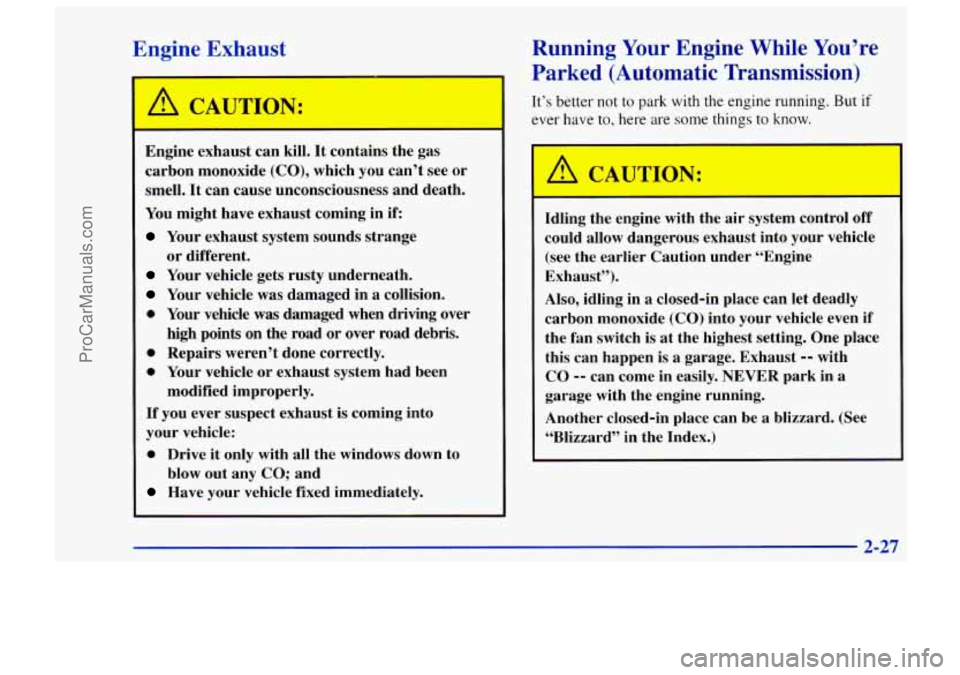
Engine Fxhauct
Engine exhaust can kill. It contains the gas
carbon monoxide
(CO), which you can’t see or
smell. It can cause unconsciousness and death.
You might have exhaust coming in if:
Your exhaust system sounds strange
Your vehicle gets rusty underneath.
Your vehicle was damaged in a collision.
0 Your vehicle was damaged when driving over
high points on the road or over road debris.
0 Repairs weren’t done correctly.
0 Your vehicle or exhaust system had been
If you ever suspect exhaust is coming into
your vehicle:
0 Drive it only with all the windows down to
Have your vehicle fixed immediately.
or
different.
modified improperly. blow out any
CO; and
Running Your Engine While You’re
Parked (Automatic Transmission)
It’s better not to park with the engine running. But if
ever have to, here are
some things to know.
A CAUTION:
Idling the engine with the air system control off
could allow dangerous exhaust into your vehicle
(see the earlier Caution under “Engine
Exhaust”).
Also, idling in a closed-in place can let deadly
carbon monoxide
(CO) into your vehicle even if
the fan switch is at the highest setting. One place
this can happen is
a garage. Exhaust -- with
CO -- can come in easily. NEVER park in a
garage with the engine running.
Another closed-in place can be
a blizzard. (See
“Blizzard” in the Index.)
~~ 2-27
ProCarManuals.com
Page 82 of 388
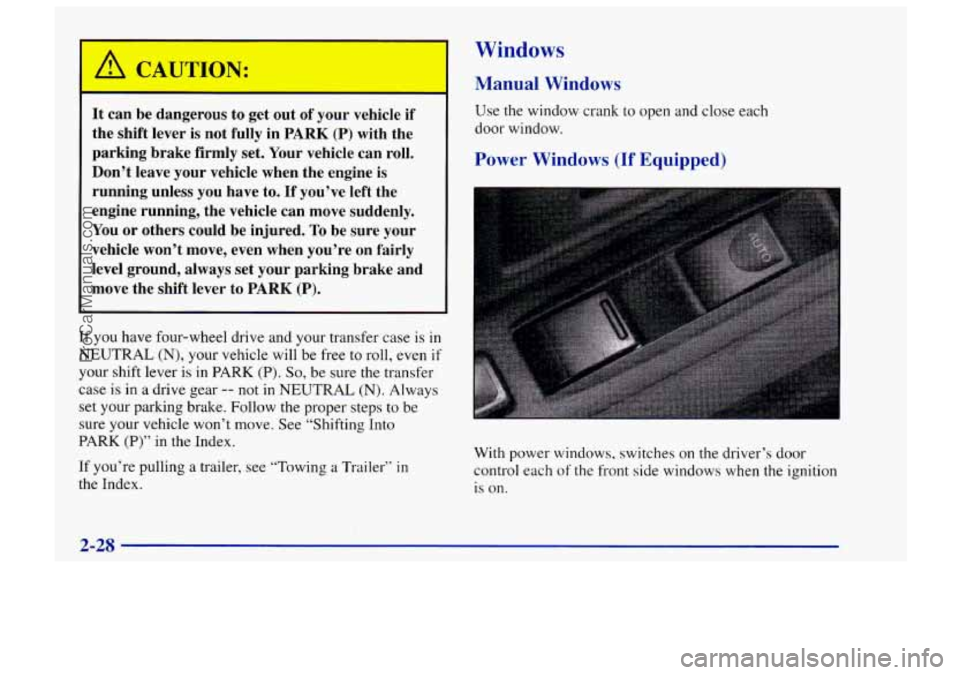
Windows
Manual Windows
7-
It can be dangerous to get out of your vehicle if
the shift lever is not fully in PARK (P) with the
parking brake firmly set. Your vehicle can roll.
Don’t leave your vehicle when the engine is
running unless you have to. If you’ve left the
engine running, the vehicle can move suddenly.
You or others could be injured.
To be sure your
vehicle won’t move, even when you’re on fairly
level ground, always set your parking brake and
move the shift lever
to PARK (P).
If you have four-wheel drive and your transfer case is in
NEUTRAL (N), your vehicle will be free to roll, even if
your shift lever is in PARK (P). So, be sure the transfer
case is
in a drive gear -- not in NEUTRAL (N). Always
set your parking brake. Follow the proper steps to be
sure your vehicle won’t move. See “Shifting Into
PARK
(P)” in the Index.
If you’re pulling a trailer, see “Towing
a Trailer” in
the Index. Use the
window crank
to open and close each
door window.
Power Windows (If Equipped)
With power windows, switches on the driver’s door
control each
of the front side windows when the ignition
is on.
2-28
ProCarManuals.com
Page 83 of 388
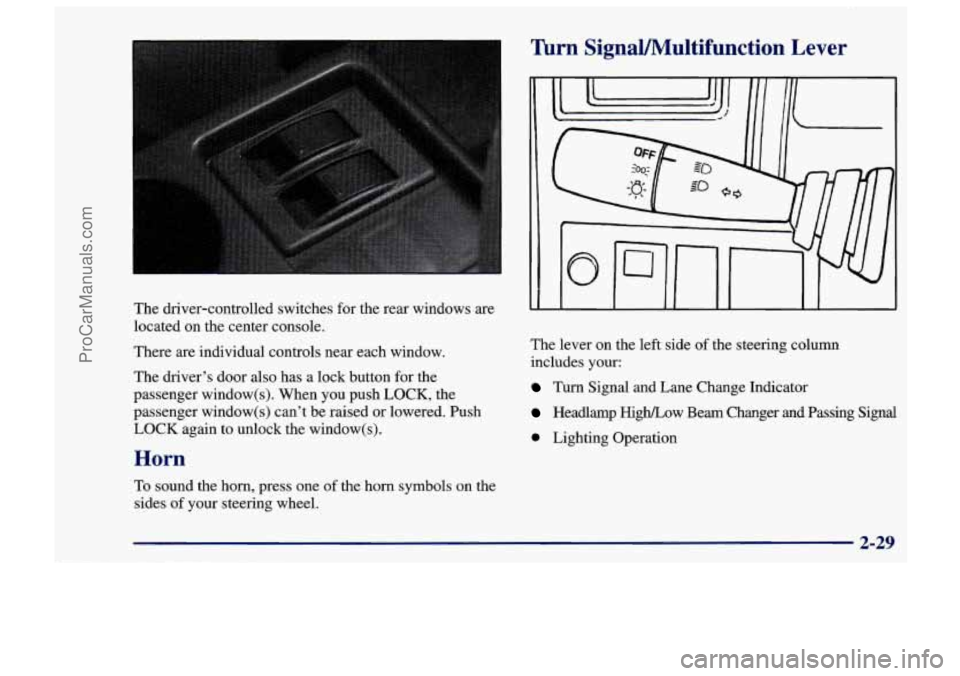
The driver-controlled switches for the rear windows are
located on the center console.
There are individual controls near each window.
The driver’s door also has a lock button for the
passenger window(s). When you push LOCK, the
passenger window(s) can’t be raised or lowered. Push
LOCK again to unlock the window(s).
Horn Turn SignaVMultifunction
Lever
The lever on the left
side of the steering column
includes your:
Turn Signal and Lane Change Indicator
Headlamp HigwLow Beam Changer and Passing Signal
0 Lighting Operation
To sound the horn, press one of the horn symbols on the
sides of your steering wheel.
ProCarManuals.com
Page 84 of 388
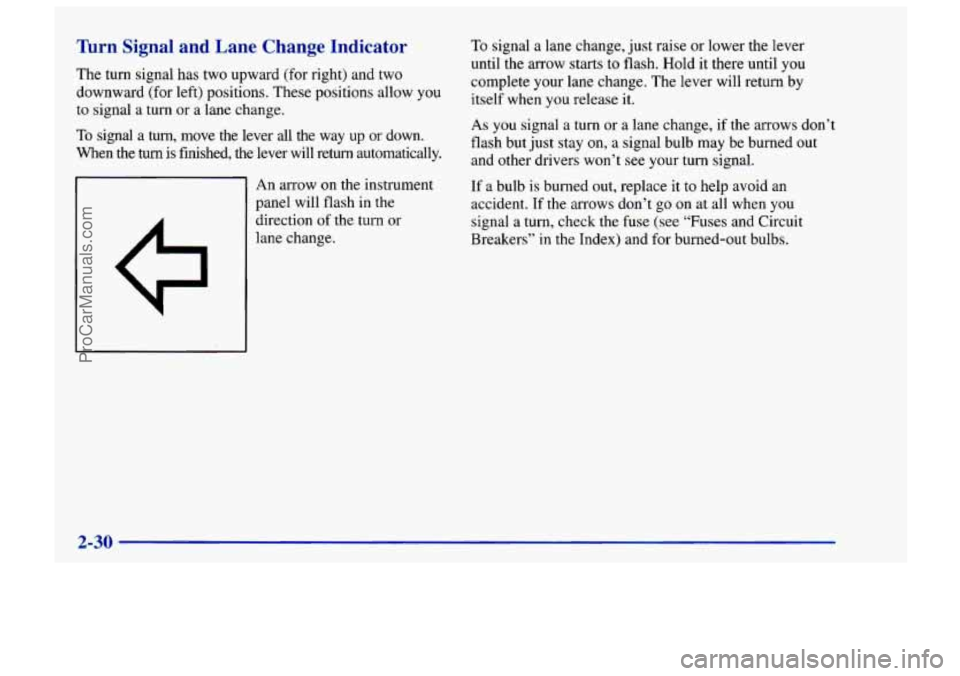
Yhrn Signal and Lane Change Indicator
The turn signal has two upward (for right) and two
downward (for left) positions. These positions allow you
to signal a
turn or a lane change.
To signal a turn, move the lever all the way
up or down.
When the
turn is finished, the lever will return automatically.
Q
An arrow on the instrument
panel will flash in the
direction of the turn or
lane change. To
signal a lane change, just raise or lower the lever
until the arrow starts to flash. Hold it there until
you
complete your lane change. The lever will return by
itself when
you release it.
As
you signal a turn or a lane change, if the arrows don’t
flash but just stay on, a signal bulb may be burned out
and other drivers won’t see your turn signal.
If a bulb
is burned out, replace it to help avoid an
accident. If the arrows don’t go on at all when you
signal a turn, check the fuse (see
“Fuses and Circuit
Breakers”
in the Index) and for burned-out bulbs.
2-30
ProCarManuals.com
Page 85 of 388
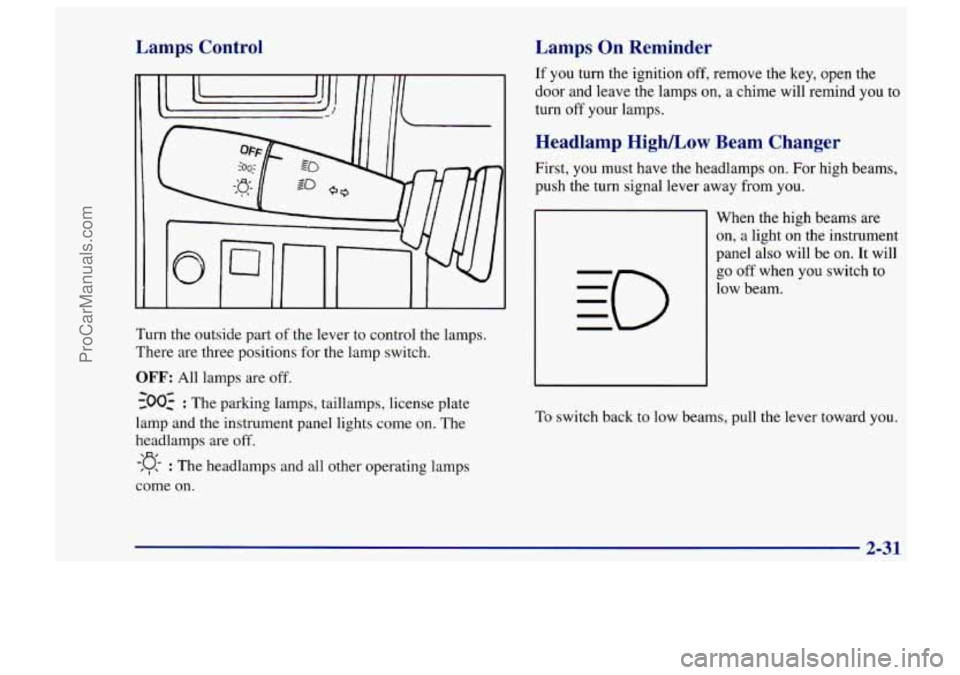
Lamps Control
Turn the outside part of the lever to control the lamps.
There are three positions for the lamp switch.
OFF: All lamps are off.
headlamps are
off.
-:(% : The headlamps and all other operating lamps
come
on.
Lamps On Reminder
If you turn the ignition off, remove the key, open the
door and leave the lamps on,
a chime will remind you to
turn off your lamps.
Headlamp High/Low Beam Changer
First, you must have the headlamps on. For high beams,
push the turn signal lever away from you.
When the high beams are
on, a light on the instrument
panel also will be
on. It will
go off when you switch to
low beam.
To switch back to low beams, pull the lever toward you.
ProCarManuals.com
Page 86 of 388
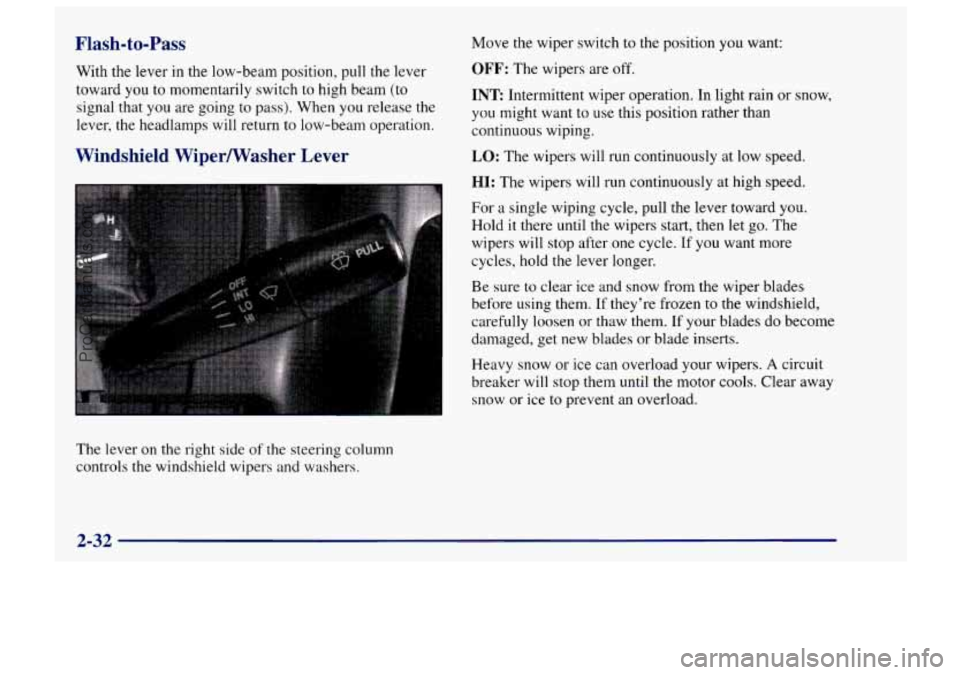
Flash-to-Pass
With the lever in the low-beam position, pull the lever
toward you to momenrarily switch to high beam (to
signal that
you are going to pass). When you release the
lever, the headlamps will return to low-beam operation.
Windshield Wipermasher Lever
The lever on the right side of the steering column
controls the windshield wipers and washers. Move
the wiper switch to the position you want:
OFF: The wipers are off.
INT Intermittent wiper operation. In light rain or snow,
you might want to use this position rather than
continuous wiping.
LO: The wipers will run continuously at low speed.
HI: The wipers will run continuously at high speed.
For
a single wiping cycle, pull the lever toward you.
Hold it there until the wipers start, then let go. The
wipers will stop after one cycle. If you want more
cycles, hold the lever longer.
Be sure to clear ice and snow from the wiper blades
before using them. If they’re frozen to the windshield,
carefully loosen
or thaw them. If your blades do become
damaged, get new blades or blade inserts.
Heavy snow
or ice can overload your wipers. A circuit
breaker will stop them
until the motor cools. Clear away
snow or ice to prevent an overload.
2-32
ProCarManuals.com
Page 87 of 388
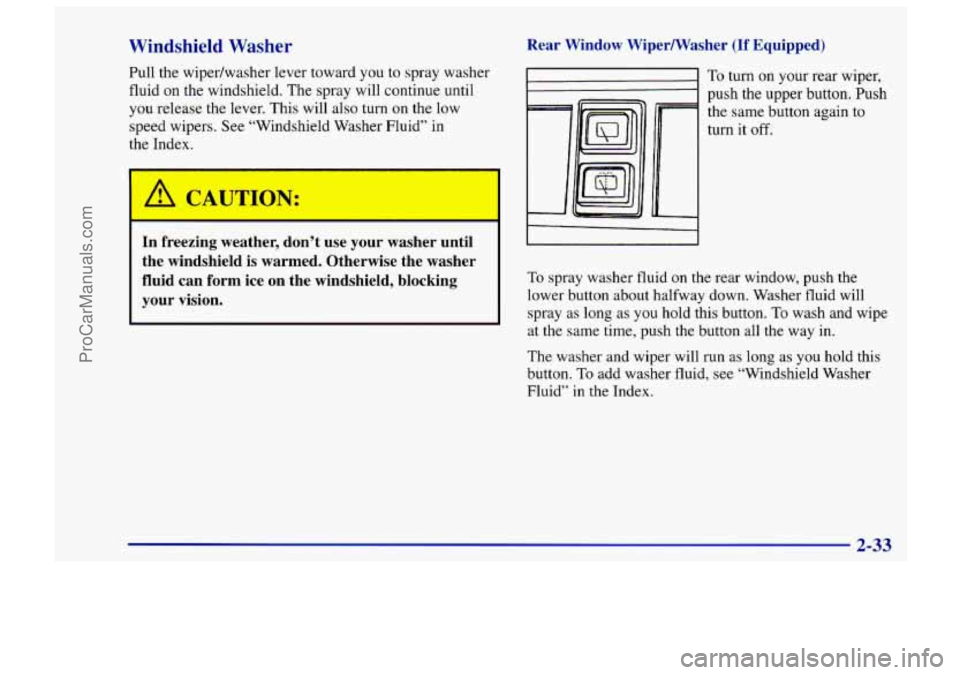
Windshield Washer
Pull the wipedwasher lever toward you to spray washer
fluid on the windshield. The spray will continue until
you release the lever. This will also turn on the low
speed wipers. See “Windshield Washer Fluid” in
the Index.
‘ A CAC-ION:
In freezing weather, don’t use your washer until
the windshield
is warmed. Otherwise the washer
fluid can form ice
on the windshield, blocking
your vision. Rear Window
WiperWasher (If Equipped)
To turn on your rear wiper,
push the upper button. Push
the same button again to
turn it off.
To spray washer fluid on the rear window, push the
lower button about halfway down. Washer fluid will
spray as long as you hold this button.
To wash and wipe
at the same time, push the button all the way
in.
The washer and wiper will run as long as you hold this
button.
To add washer fluid, see “Windshield Washer
Fluid”
in the Index.
2-33
ProCarManuals.com
Page 88 of 388
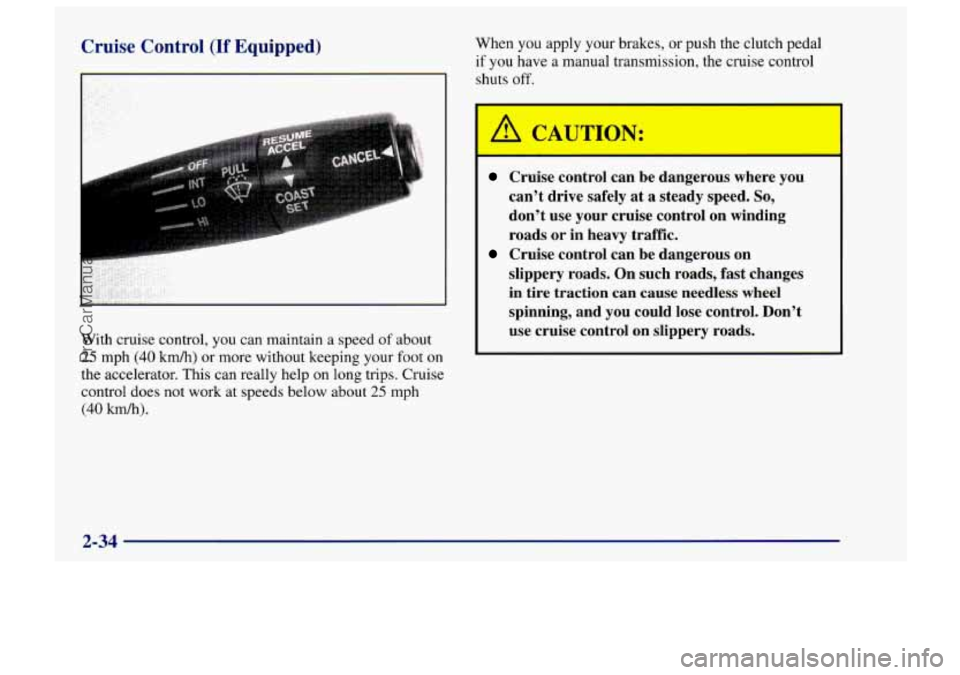
Cruise Control (If Equipped)
With cruise control, you can maintain a speed of about
25 mph (40 km/h) or more without keeping your foot on
the accelerator. This can really help on long trips. Cruise
control does not work at speeds below about
25 mph
(40 kmh). When you
apply your brakes, or push the clutch pedal
if you have a manual transmission, the cruise control
shuts
off.
Cruise control can be dangerous where you
can’t drive safely at a steady speed.
So,
don’t use your cruise control on winding
roads
or in heavy traffic.
slippery roads. On such roads,
fast changes
in tire traction can cause needless wheel
spinning, and you could lose control. Don’t
use cruise control on slippery roads.
Cruise control can be dangerous on
2-34
ProCarManuals.com
Page 89 of 388
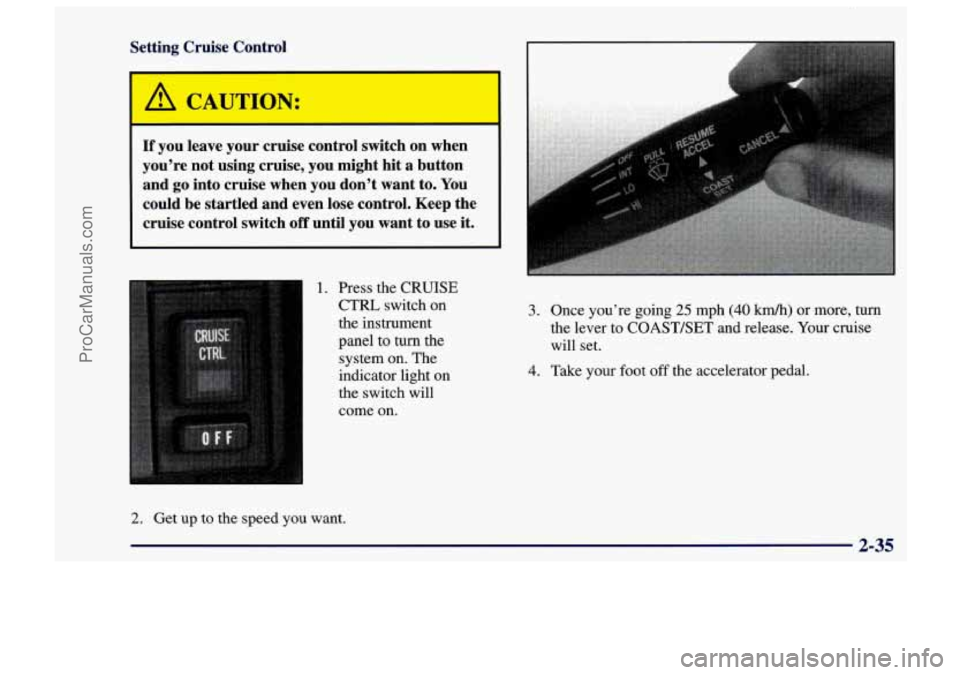
Setting Cruise Control
If you leave your cruise control switch on when
you’re not using cruise, you might hit a button
and
go into cruise when you don’t want to. You
could be startled and even lose control. Keep the
cruise control switch
off until you want to use it.
1. Press the CRUISE CTRL switch on
the instrument
panel to
turn the
system on. The
indicator light on
the switch will
come on.
2. Get up to the speed you want.
3. Once you’re going 25 mph (40 km/h) or more, turn
the lever to COASTBET and release. Your cruise
will set.
4. Take your foot off the accelerator pedal.
2-35
ProCarManuals.com
Page 90 of 388
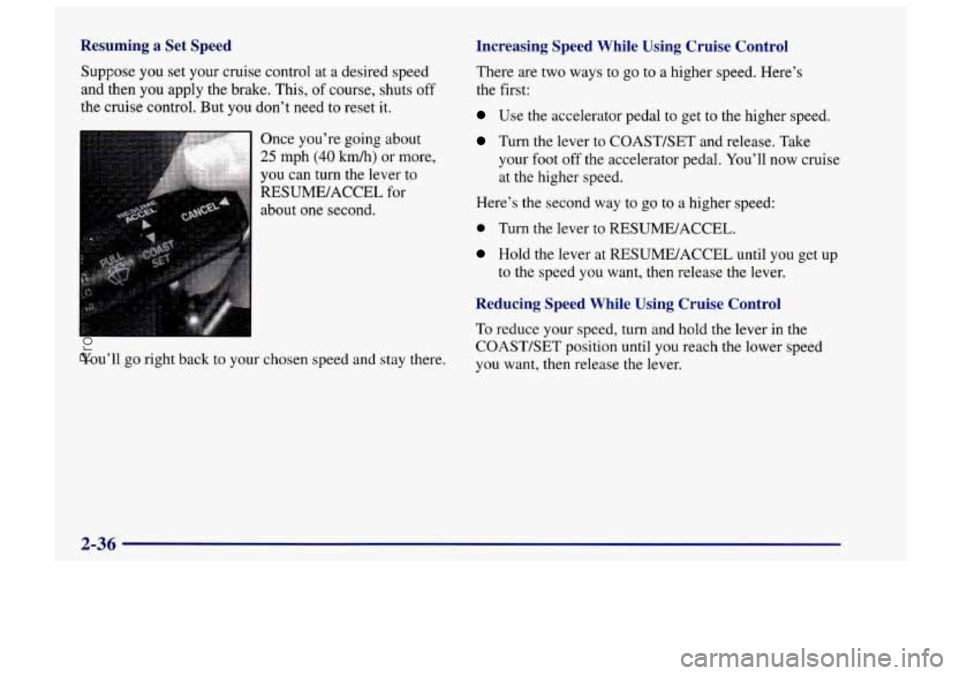
Resuming a Set Speed
Suppose you set your cruise control at a desired speed
and then you apply the brake. This, of course, shuts off
the cruise control. But you don’t need to reset it.
Once you’re going about
25 mph (40 km/h) or more,
you can turn the lever to
RESUME/ACCEL for about one second.
Increasing Speed While Using Cruise Control
There are two ways to go to a higher speed. Here’s
the first:
Use the accelerator pedal to get to the higher speed.
Turn the lever to COAST/SET and release. Take
your foot off the accelerator pedal. You’ll now cruise
at the higher speed.
Here’s the second way to
go to a higher speed:
0 Turn the lever to RESUME/ACCEL.
Hold the lever at RESUMEIACCEL until you get up
to the speed you want, then release the lever.
Reducing Speed While Using Cruise Control
I To reduce your speed, turn and hold the lever in the
COAST/SET position until you reach the lower speed
You’ll
go right back to your chosen speed and stay there. you want, then release the lever.
2-36
ProCarManuals.com